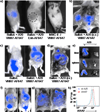Structurally Defined αMHC-II Nanobody-Drug Conjugates: A Therapeutic and Imaging System for B-Cell Lymphoma
- PMID: 26840214
- PMCID: PMC4820396
- DOI: 10.1002/anie.201509432
Structurally Defined αMHC-II Nanobody-Drug Conjugates: A Therapeutic and Imaging System for B-Cell Lymphoma
Abstract
Antibody-drug conjugates (ADCs) of defined structure hold great promise for cancer therapies, but further advances are constrained by the complex structures of full-sized antibodies. Camelid-derived single-domain antibody fragments (VHHs or nanobodies) offer a possible solution to this challenge by providing expedited target screening and validation through switching between imaging and therapeutic activities. We used a nanobody (VHH7) specific for murine MHC-II and rendered "sortase-ready" for the introduction of oligoglycine-modified cytotoxic payloads or NIR fluorophores. The VHH7 conjugates outcompeted commercial monoclonal antibodies (mAbs) for internalization and exhibited high specificity and cytotoxicity against A20 murine B-cell lymphoma. Non-invasive NIR imaging with a VHH7-fluorophore conjugate showed rapid tumor targeting on both localized and metastatic lymphoma models. Subsequent treatment with the nanobody-drug conjugate efficiently controlled tumor growth and metastasis without obvious systemic toxicity.
Keywords: antibody-drug conjugates; antitumor agents; imaging agents; nanobodies; sortase.
© 2016 WILEY-VCH Verlag GmbH & Co. KGaA, Weinheim.
Figures




References
-
- Shan D, Ledbetter Ja, Press OW. Blood. 1998;91:1644–1652. - PubMed
-
- Mayumi M, Sumimoto S, Kanazashi S, Hata D, Yamaoka K, Higaki Y, Ishigami T, Kim KM, Heike T, Katamura K. J. Allergy Clin. Immunol. 1996;98:S238–S247. - PubMed
-
- Dechant M, Bruenke J, Valerius T. Semin. Oncol. 2003;30:465–475. - PubMed
-
- von Bergwelt-Baildon M. Ann. Oncol. 2004;15:853–857. - PubMed
Publication types
MeSH terms
Substances
Grants and funding
LinkOut - more resources
Full Text Sources
Other Literature Sources
Research Materials
Miscellaneous

